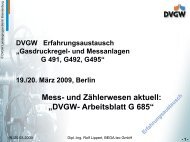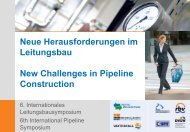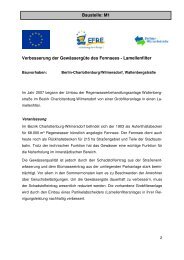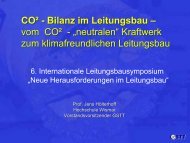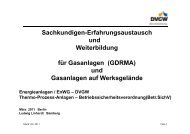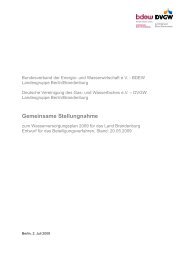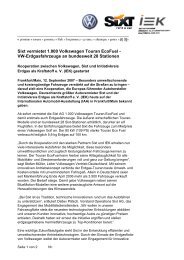Source: Bulgartransgas EAD - DVGW
Source: Bulgartransgas EAD - DVGW
Source: Bulgartransgas EAD - DVGW
You also want an ePaper? Increase the reach of your titles
YUMPU automatically turns print PDFs into web optimized ePapers that Google loves.
Spotlight Bulgaria: Experiences in Network<br />
Maintenance in Bulgaria<br />
Dr. Georgi<br />
Overgas<br />
Nikolov<br />
Inc.<br />
VI INTERNATIONAL CABLE AND PIPELINE SYMPOSIUM<br />
– 02 April 2009, Berlin<br />
NEW CHALLENGES IN CABLE AND PIPELINE CONSTRUCTION
Pipelines and Cables - Basis of Modern Infrastructure<br />
This is a high priority infrastructure because it ensures:<br />
Vital living conditions;<br />
Energy – heat, light;<br />
Water supply to population;<br />
Communications – information;<br />
Sustainable development of community and the<br />
world.<br />
Environmental protection is<br />
a prerequisite for the infrastructure development.
50%<br />
40%<br />
30%<br />
20%<br />
10%<br />
0%<br />
The State of Gas Pipeline Design and Construction<br />
Depends on the Gas Market<br />
Comparison of Bulgarian gas market with the EU average level<br />
Share of municipalities with access to the<br />
transmission network (%)<br />
Bulgaria<br />
EU 27<br />
15<br />
80<br />
0 50 100<br />
Share of natural gas and electricity in Final Energy Consumption of households in EU -27 and Bulgaria<br />
Bulgaria ЕU<br />
35%<br />
Electricity<br />
11%<br />
2%<br />
45%<br />
Natural gas<br />
Natural gas consumption per capita (m 3 )<br />
Bulgaria<br />
EU 27<br />
100%<br />
90%<br />
80%<br />
70%<br />
60%<br />
50%<br />
40%<br />
30%<br />
20%<br />
10%<br />
0%<br />
450<br />
949<br />
0 500 1000 1500<br />
Structure of natural gas consumption in EU-27 and Bulgaria<br />
47%<br />
50%<br />
3%<br />
22,10%<br />
39,40%<br />
38,50%<br />
Bulgaria EU<br />
<strong>Source</strong>: Bulgarian Natural Gas Association<br />
Energy sector<br />
Industry<br />
Household and<br />
services
EUR/kWh<br />
Price of Energy <strong>Source</strong>s for Residential Sector<br />
0,100<br />
0,090<br />
0,080<br />
0,070<br />
0,060<br />
0,050<br />
0,040<br />
0,030<br />
0,020<br />
0,010<br />
0,000<br />
0,093<br />
0,089<br />
0,056 0,053<br />
Prices on 05.03.2009, incl. VAT<br />
0,022<br />
Electricity – household, daily tariff Industrial gas oil<br />
Pricing Natural is based gas on: – residential consumers<br />
Black coal<br />
Heat energy – average for district heating plants
orecasts for Natural Gas Consumption<br />
The expansion of natural gas use is a priority objective in Bulgaria’s energy<br />
strategy.<br />
Consumption Bcm/y<br />
5<br />
4,5<br />
4<br />
3,5<br />
3<br />
2,5<br />
2<br />
1,5<br />
1<br />
0,5<br />
0<br />
Year<br />
3,4 3,7 4,2 4,7<br />
2008 2010 2015 2020
Natural Gas Transmission Pipelines in Bulgaria
Basic parameters of the gas transmission system:<br />
National transportation system –<br />
-<br />
length -<br />
1<br />
- 3 compressor stations<br />
- operation pressure –<br />
a closed ring with branches;<br />
700 km, diameter from 200 –<br />
1 000 mm;<br />
(Kardam, Valchi Dol, P. Cenovets) –<br />
55 bar.<br />
Тransit gas system to Turkey(13.71 bcm/y, Greece (2.85 bcm/y) and<br />
Macedonia(0.12 bcm/y);<br />
-<br />
length -<br />
945<br />
km , diameter from 500 to 1220 mm<br />
- 6 compressor stations (Kardam, Provadia, Lozenets, Straldzha,<br />
Ihtiman, Petrich) – 214 MW;<br />
- operation pressure –<br />
55 bar.<br />
One underground gas storage Chiren:<br />
- maximum daily production - 4.3 mcm /d;<br />
- maximum daily injection – 4.0 mcm /d;<br />
- active volume - 450 mcm ;<br />
<strong>Source</strong>: Bulgartransgaz<br />
49 MW;
Towns with Gas Distribution Network in Place<br />
Gas distribution networks are built in:<br />
Gas Distribution Companies Towns with Gas Distribution Network in Place<br />
Sofiagas <strong>EAD</strong> (Subsidiary of Overgas Inc. AD) Sofia, Bozhuriste<br />
Overgas Yug <strong>EAD</strong> (Subsidiary of Overgas Inc. AD) Asenovgrad, Pazardzhik, Parvomay<br />
Overgas Zapad <strong>EAD</strong> (Subsidiary of Overgas Inc. AD) Kyustendil, Montana, Petrich, Mezdra<br />
Dunavgas <strong>EAD</strong> (Subsidiary of Overgas Inc. AD) Ruse, Veliko Tarnovo, Razgrad, Gorna<br />
Overgas<br />
Total length of gas distribution networks ~ 3 000 km, of which<br />
Steel gas pipelines ~ 500 km;<br />
PEHD – gas pipelines ~ 2 500 km<br />
Oryahovitsa, Lovech, Levski and etc.<br />
Iztok <strong>EAD</strong> (Subsidiary of Overgas Inc. AD) Burgas, Varna, Stara Zagora, Yambol, Nova Zagora, Novi Pazar<br />
Citigas AD Plovdiv, Karlovo, Haskovo<br />
Black Sea Technology Company AD Dobrich, Pleven, Targovishte<br />
TASSY OOD Kneja, Dolni Dabnik<br />
Kavarnagas AD Kavarna<br />
Sevlievogas AD Sevlievo<br />
Balkangas AD Botevgrad, Pravets, Trudovets<br />
Komekes AD Samokov, Borovets<br />
Rilagas AD Blagoevgrad, Dupnitsa<br />
Kamenogas AD Kameno<br />
and etc.
Gas Distribution Networks<br />
Basic (parameters) characteristics:<br />
Configuration –<br />
closed ring networks with branches from them;<br />
Structure – distribution gas pipelines, gas regulating installations, gas<br />
measuring installations, odorizing installations, gas line valves, cathode<br />
stations and etc;<br />
Twoor three-stage pressure regulation<br />
- up to 0.01 MPa<br />
- 0.01 – 0.2 MPa<br />
- 0.2 - 0.5 MPa<br />
- 0.5 - 1.6 MPa<br />
Technological Scheme of Gas Distribution Network<br />
1- Main branch pipeline; 2- Distribution gas pipelines; 3- Automatic Gas Regulating and Measuring Station; 4- Linear valve for<br />
underground assembly; 5- Linear valve; 6- Condense collector; 7- Return valve; 8- Gas Regulating Station- 1C (City); 9- Gas<br />
Regulating and Measuring Station; 10- Gas Regulating Station – 1I (Industrial); 11- Gas measuring Station; 12- Gas Regulating and<br />
Measuring Installation; 13- Gas Regulating Installation; 14- Odorizing Installation; 15- Electro-chemical protection of steel gas<br />
pipelines; 16- User Gas Pipeline branch
Gas Distribution Network Scheme of Sofia
Requirements to the Gas Pipeline Networks<br />
The gas networks and related facilities secure the transportation of gas to the various<br />
consumers in the built-up area. In accordance with the indicators for gas supply<br />
quality the networks are to meet the following basic requirements:<br />
high reliability and continuity of gas supply to the consumers according to<br />
their category;<br />
safe and efficient operation;<br />
precise measuring of the gas flow and gas quantities sold to the consumers<br />
controlled gas quality, and odorizing, securing safety of use;<br />
optimal configuration and degree of pressure regulation;<br />
optimal overhaul and operational costs;<br />
environmental protection;<br />
optimal matching to the infrastructure of built-up areas;<br />
ensured protection against third party interference;<br />
monitoring and control of network parameters through automated<br />
information management system including identification of pre-emergency<br />
and emergency modes.
Let us benefit from the experience of the leaders<br />
and avoid their mistakes<br />
Maintenance of pipeline networks in Bulgaria – one of the new EU membercountries,<br />
is based on:<br />
Efficient use of experience of EU and other countries;<br />
Harmonization of Bulgarian technical standards with European<br />
norms;<br />
Avoidance of others’ mistakes;<br />
Implementation of new technologies and equipment;<br />
Application of state-of-the-art information technologies<br />
(PIMS – Pipeline Integrity Management System) and others;<br />
Setting of state-of-the-art management models (Business Excellence).
Avoidance of others’ mistakes:
Maintenance of Gas Networks<br />
Reliability of gas supply is the property of the gas supply system to deliver the<br />
required natural gas volume to the consumers uninterrupted, under the contract terms,<br />
in compliance with pre-set working parameters and within a certain time frame.<br />
The gas supply reliability rate is:<br />
determined in the concept project;<br />
underlying the working projects, the procurement of materials and<br />
equipment, the implementation and control of construction works and<br />
commissioning;<br />
maintained in the course of the system operation and restoration during<br />
implementation of restoration-repair works.<br />
Bulgartransgaz <strong>EAD</strong> and Overgas Inc. subsidiaries use SCADA system.<br />
SCADA serves to monitor the network pressure and flows, the natural gas<br />
composition and specific burning heat, the condition of the stop and control valves,<br />
the parameters of the devices. The data transfer is made through optic cable lines,<br />
telephone lines, satellite and radio connectivity. SCADA uses logic modeling<br />
programs, electronic equipment and standardization of computing networks.
Maintenance of Gas Networks<br />
Operation of the gas network is run in compliance with the gas companies’ procedures<br />
and instructions which are part of the Quality Management System under BSS<br />
(Bulgarian State Standard) ISO 9000-2008, BSS EN 12007-1,4 and other standards of<br />
TC-234-Gas Supply - CEN. Practices based on the <strong>DVGW</strong> documents and experience<br />
are also applied.<br />
The gas companies generate, maintain and store the operation documentation in the<br />
format and volume in compliance with the statutory requirements during the complete<br />
operational period of the energy sites. Part of the documentation is stored electronically.<br />
The documentation contains the following minimum volume of:<br />
acts of approval and commissioning;<br />
executive documentation of the gas pipelines and facilities;<br />
underground cadastre in the area of the gas pipe line;<br />
technical passports of the gas pipelines valves and facilities (files<br />
including description of the check-ups and repairs made);<br />
operational log of the dispatch center;<br />
action plan in case of emergency and<br />
emergency-restoration works;<br />
procedure of leak detection.
Maintenance of Gas Networks<br />
The diagnostics is carried out through technical examination, tracking their route,<br />
pressure measuring, mode modelling (computer monitoring), gas balance control,<br />
in-pipe diagnostics with intelligent monitoring pigs (next slide).<br />
Tracking the gas pipe line route<br />
main pipelines with pressure ≤5,5 MPa<br />
–<br />
once in 2 months;<br />
gas pipe line with pressure ≥0.4 MPa – twice a month at least;<br />
gas pipe line with pressure ≤0.1 MPa and Main Branch Pipeline from an Automatic<br />
Gas Regulation and Measuring Station outside a built-up area– once a month at<br />
least.<br />
Tracking the route of the distribution networks involves the following activities:<br />
measuring of the safety potential of the cathode station for metal gas pipelines;<br />
check-up of working pressure in Gas Regulation Station and Gas Regulation and<br />
Measuring Installations;<br />
reflecting any construction and assembly works under way in the proximity of the<br />
gas pipelines;<br />
check-up for the presence of natural gas in the shafts of other utilities<br />
(communication, sewage) etc.<br />
the minimum time span of the technical examination for steel gas pipelines is once<br />
in 4 years;
Intelligent Pipeline Monitoring Pig<br />
<strong>Source</strong>: Bulgartransgaz
Maintenance of Gas Networks<br />
The reliability, safety and efficiency of the gas networks are secured by a system for<br />
their technical maintenance and repairs. This system has two major aspects:<br />
а) Maintenance and repair organization including:<br />
maintenance structure (territorial location of the repairoperational facilities, number and qualification of the repair staff);<br />
typization, sequence and matching of works;<br />
logistics;<br />
b) Current maintenance management including:<br />
technical condition control, planning of schedule and volume of works;<br />
organizational-technical management of staff and technical repair<br />
equipment.<br />
In the course of the system operation the necessary measures are undertaken to run<br />
preventive maintenance on industrial consumers’ days-off or in certain consumers’<br />
off-peak periods. In this manner the faulty element of the system can be switched off<br />
without affecting the consumer. This aims to restore and maintain the pre-set<br />
reliability level through a relevant analysis of the reliability of the individual system<br />
elements and scheduled check-ups and repairs.
Maintenance of Gas Networks<br />
The Preventive Maintenance(PM) System for gas distribution networks is<br />
statutorily well regulated.<br />
The statutory requirements are entirely based on:<br />
the recommendations of the equipment manufacturers and the experience<br />
from its operation;<br />
the specific<br />
qualification;<br />
operational conditions and the actual staff<br />
the actual technical state of the equipment and logistics;<br />
their resource use rate;<br />
technological systems and impact of reserve on reliability,<br />
schedule and emergency stoppages,;<br />
their repercussions and related repair costs;<br />
the indicators of the pipeline system functioning as well.<br />
off-
Maintenance of Gas Networks<br />
Repairs of gas pipelines includes:<br />
replacement of certain sections of gas pipelines;<br />
restoration or re-enforcement of the gas pipeline walls with emergency<br />
brackets;<br />
Emergency (repair) brackets of Mat Ltd. for gas distribution pipelines<br />
replacement of the surface gas pipeline supports;<br />
replacement of gas pipeline terminals;<br />
replacement of valve units;<br />
displacement of gas pipelines.
Repair of Gas Pipeline with External Corrosion<br />
<strong>Source</strong>: Bulgartransgaz
Lessons from the Crisis – January 2009<br />
On 06.01.2009 natural gas supplies through Ukraine were stopped which resulted in:<br />
introduction of a restrictive regime and daily consumption decrease from 12.5<br />
mcm/d to 5.7-6.2 mcm/d;<br />
gas supply only to residential users, public-administrative users (schools,<br />
kindergartens, hospitals, etc.) and industrial users with continuous<br />
production;<br />
maximum daily production from UGS – Chiren – 4.3 mcm/d;<br />
use of accumulated capacity of gas pipelines;<br />
creation of technical conditions for receipt of 2.5 mcm/d through reverse<br />
operation of the transit pipeline to Greece.<br />
The experts from Bulgartransgaz, the subsidiaries of Overgas Inc., Citigas and others,<br />
ensured an emergency-free operation of the gas supply system in the conditions of strict<br />
restrictive regime.
Lessons from the Crisis<br />
Lessons from the crisis caused by the suspended natural gas supplies through Ukraine.<br />
It is necessary:<br />
To speed up the introduction of the European regulatory framework into the<br />
Bulgarian energy sector;<br />
Designing and construction of closed gas pipeline networks<br />
with an option for reversible running.<br />
To implement the energy strategy projects:<br />
- South Stream<br />
- NABUCCO<br />
- Construction of an LNG re-gasification terminal;<br />
- Upgrading and expanding the Chiren UGS;<br />
- Building new gas storage facilities (Galata and others);<br />
- Building inter-system gas pipeline connections with<br />
the networks of Greece (Komotini- Dimitrovgrad)<br />
and Romania (Ruse-Gyurgevo).<br />
<strong>Source</strong>: <strong>Bulgartransgas</strong> <strong>EAD</strong>
Cooperation for addressing problems<br />
Ministry of Economy and<br />
Energy<br />
Ministry of<br />
Environment<br />
and Water<br />
Ministry of Regional<br />
Development and Public<br />
Works<br />
Non-Government<br />
Organisations<br />
State Energy and<br />
Water Regulatory<br />
Commission<br />
State Agency of<br />
Metrology and<br />
Technical<br />
Supervision<br />
Regional and<br />
Municipal<br />
Governments<br />
Ministry of Education and<br />
Sciences<br />
Bulgartransgaz<br />
Licensed Gas<br />
Distribution Companies<br />
GAS Companies<br />
Ministry of<br />
Finance
Regulation vs. Liberalization<br />
Regulation<br />
Liberalization
Thank You for Your Attention!<br />
Dr. Georgi Nikolov, Overgas Inc.<br />
Tel.: +359 2 42 83 245<br />
Mob.: +359 893 345 004<br />
E-mail: georgi_nikolov@overgas.bg




